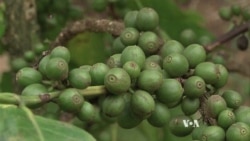Forests can help to reduce hunger and improve nutrition for millions of people, according to a major report released at the United Nations.
The world population is expected to climb to 9 billion by 2050. By that time the demand for food will double. Accommodating those future needs is a concern today, especially for the more than 800 million people who go to bed hungry.
In its report, the International Union of Forest Research Organizations (IUFRO), the world’s largest network of forest scientists, notes that healthy forests provide half the fresh fruit we consume. They produce valuable commodities like coffee, avocados, cashews and other seeds popular on the world market.
The products are also rich in vitamins, proteins and other nutrients. The iron content of dried seeds of the African locust bean and raw cashew nut are comparable with, or even higher than, that of chicken meat, the report says.
Tree foods can also be a safety net for people living in and around the forest, said Bhaskar Vira, director of the University of Cambridge Conservation Research Institute and chairman of the IUFRO panel that wrote the report.
He compared it to an insurance policy. “Having access to tree-based foods is hugely important when you can’t buy food from other sources or when you can’t produce food because your fields have failed,” he said.
Complementary activities
Yet agriculture is a major driver of deforestation. Vira said the two can co-exist, even complement each other, if managed properly.
“The neglect of those forest foods is one of the reasons why people are willing to clear them and convert them over to agriculture," he said. "We are arguing that you should think about that landscape as a much more integrated production landscape.”
Agricultural yields in one place, Vira added, can free up other areas to retain trees and the products and services they provide.
What keeps people hungry is often not lack of food, but lack of access to that food and control over its production, Vira said. “When people have greater control over the resources, forest health, its economic value and the lives of the people improve,” he said.
Take, for example, the locally managed agro-forestry project in Ghana where people hope to reap profits from Allanblackia, a fruit-bearing plant. The oil from its seed can be used in soaps, beauty products and food. According to project coordinator Okai Michael Henchard, communities "get additional income. They get trees on their land. It provides shade to [understory crops] and then collectively we restore the land.”
“Allanblackia also sequesters carbon,” he added, “so it is helping to fight climate change.”
'Vigilant' about resource use
Vira cautioned that overharvest can bring ruin. “We don’t want to be in a situation where we are overexploiting this resource and then reducing its long-term sustainability," he said. "So we have to be quite vigilant, especially when you get market value imposed on these commodities and the desire for short-term profitability sometimes competing with the long-term sustainability of the resource.”
The report underscores the importance of reimagining forested and agricultural landscapes through careful management and good governance. Vira said that approach, if done right, can help alleviate hunger and poverty worldwide.
Sixty scientists from around the world collaborated on the publication, Forests, Trees, Landscapes for Food Security and Nutrition, A Global Access Report.











